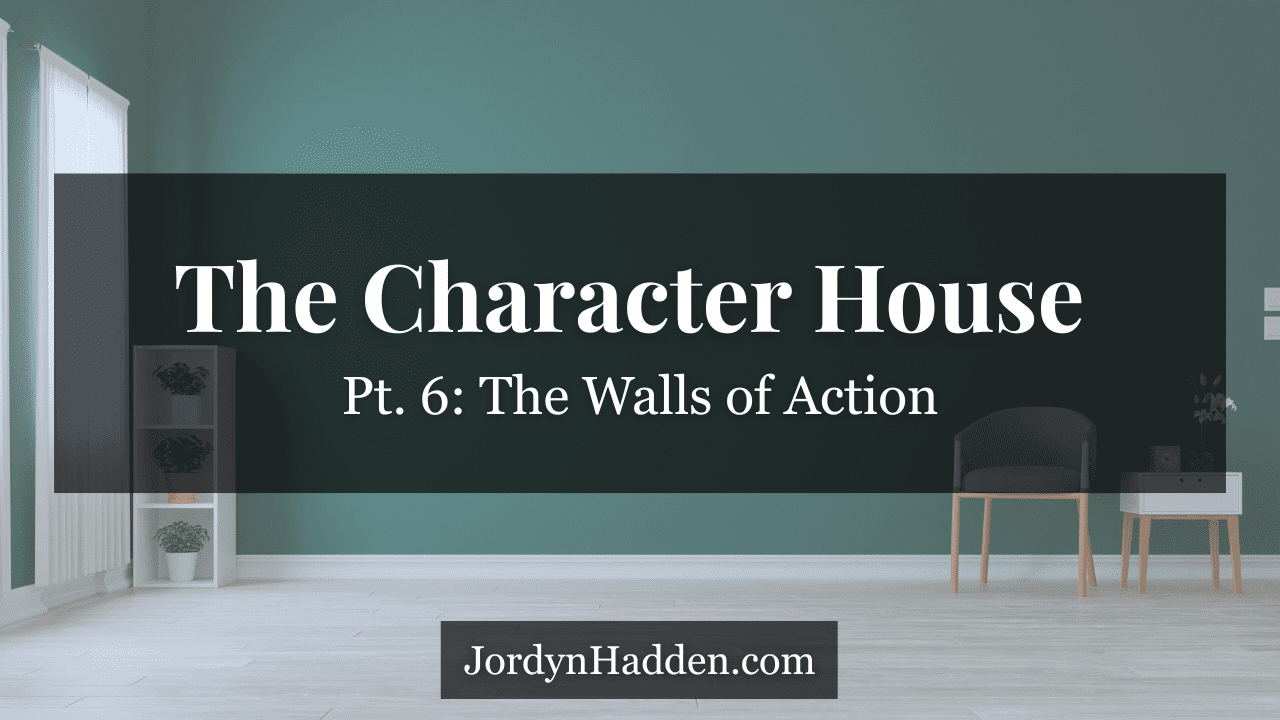Your characters might have tearjerking backstories, compelling goals, and witty dialogue. But if they don’t do anything, your story will go nowhere.
The Character House compares the components of a character to the parts of a house. Just as the walls of a house rest on the first floor and basement, characters’ dialogue and actions depend on their backstories, fears, and goals. When you know what your characters want, fear, and believe, you can determine what they will say and do to achieve those goals.
Actions Speak Louder Than Words
This post defines actions as decisions—the choices that your characters make. Even when a story doesn’t contain “action-packed” car chases or battle scenes, it should show characters making decisions that drive the plot forward.
This article can’t tell you exactly what specific actions your characters should take in your story. That would require specialized guidance tailored to your novel (which I’m happy to provide in Developmental Editing!). Instead, this post will explore general advice on making sure your characters’ actions are logical, meaningful, and fascinating.
1. Keep the characters’ goals in mind.
In a well-constructed house, the floor supports the walls. Likewise, in a well-developed character, the First Floor Fears and Goals support the Walls of Dialogue and Actions. In other words, characters’ goals influence the actions they take and the decisions they make.
In each scene, the character makes a decision to pursue a particular scene goal. But an obstacle forces the character to react and make a new decision.
Suppose a character named Daniel is trying to win a cooking competition. In one scene, Daniel’s goal is to win round one by cooking the perfect entrée, so he makes the decision to prepare a potato soufflé. But he faces the obstacle of accidentally leaving the oven too hot, which burns his meal. Now he makes a new decision to scrape off the burned parts and serve his dish to the judges. He just barely avoids being eliminated, so he makes a new decision to cook an even more amazing meal in round two of the competition. This sequence of decisions, obstacles, and reactions continues throughout the story.
2. Consider the character’s beliefs.
Every action, no matter how small, results from a belief, whether true or false. Minor beliefs, such as “I’m running late,” lead to minor actions, such as rushing to get ready for school. By contrast, major beliefs, especially the character’s Lie, lead to drastic actions, such as sabotaging relationships.
When you’re stuck on a scene, don’t simply ask, “What should my character do in this scene?” Instead, ask this question: “What does my character believe in this scene, and how do those beliefs impact his or her actions?”
3. Don’t force your characters to do things for the plot.
When characters behave naturally, their beliefs drive their behaviors in a logical way. On the other hand, when characters’ actions feel unnatural, the author may be forcing the characters to behave in ways that don’t stem from their natural beliefs about the circumstances.
If you encounter a mismatch between your plot and characters, you have a few options. You can revise the plot to fit the character, revise the character to fit the plot, or alter the character’s motivation.
4. Present the characters with difficult choices.
You don’t really know a person until you see him or her under pressure. For this reason, forcing characters to make decisions under pressure reveals their true principles and priorities.
In a simple way, the middle grade Choose Your Own Adventure books illustrate this principle. Written in second person present tense, these books place the reader in the story as the main character. Each page ends with a dilemma: “To make choice A, turn to page 43. To make choice B, turn to page 59.” Your choices influence how the story ends. In some endings, you survive; in others, you don’t.
Difficult decisions raise the stakes and prevent your characters from becoming passive. Passive characters let the plot happen to them instead of making decisions that drive the story forward. To avoid this problem, you can make the cost of not acting greater than the cost of acting.
5. Establish our expectations—and then break them.
In general, characters should behave consistently. As mentioned under point 2, characters’ actions stem from their beliefs about the world. For example, Julia might believe that it’s best to look on the bright side, so she remains cheerful in the face of difficulty. Likewise, Anthony might believe that no one can be trusted, so he barks gruff comments at anyone who tries to get close to him.
However, characters shouldn’t react the exact same way in every single situation. They might be keeping secrets, or they might have conflicting beliefs and goals. A character who responds the same way to every situation can become flat and unrealistic.
Returning to our examples, Julia should have moments when trials dampen her optimism, and Anthony should occasionally reveal a tender side. These surprising reactions display well-rounded characters.
Taking Action
In a house, the walls rest squarely on top of the basement and first floor. Similarly, characters’ actions and decisions stem from their backstories, beliefs, fears, and goals. To develop realistic decisions, consider what your characters believe and want in the scene. Present them with difficult choices that reveal their priorities under pressure. Finally, try to create situations where their reactions break the norm and surprise your audience.
As you apply these tips to your characters’ choices, their actions will propel your plot and keep your readers on the edge of their seats.
What’s the most difficult dilemma your protagonist faces in your story?
Want more posts like this one? Sign up to receive new blog posts in your inbox. You’ll also receive my monthly newsletter, featuring encouragement, announcements, and writing tips to inspire your creative journey!


Ooh, once again a great post!
And yes, keeping your character’s responses consistent throughout (or in the case of a character arc, gradually and realistically changing to fit the arc) is a huge part of writing good characters and can make or break a book!
And again I love the exercises you have at the end! The last one is one I love to play around with in my imagination, even if it never shows up in the story—what would make my character react in ways they wouldn’t normally act? What would break my character? The more I know as the author, the fuller the character becomes!
I’m looking forward to the next post!
Thank you so much! Your comments are very encouraging.
I completely agree. On the one hand, it’s important for the characters to behave consistently, but on the other hand, their actions and responses should slowly change to show a character arc. It’s a difficult balance to strike, but the challenge is part of the fun. 🙂